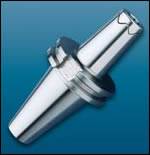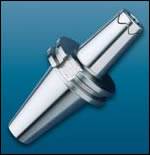Shrink-Fit System Helps Moldmaker Boost CNC Accuracy, Productivity and Tool Life
Fine tuning a CNC machine for maximum speed and having the ability to run lights-out machining means controlling a wide variety of elements like tool holding. The inherent benefit of shrink-fit technology, as compared to other tool holding options, is that it virtually eliminates the toolholder as a variable for error.
When you pay millions of dollars for the CNC machines in your shop, you want maximum payback from your investment. Equipment that sits idly costs money, as does equipment that is intended to run lights-out but that cannot run without supervision.
Fine tuning a CNC machine for maximum speed and having the ability to run lights-out machining means controlling a wide variety of elements like tool holding. The inherent benefit of shrink-fit technology, as compared to other tool holding options, is that it virtually eliminates the toolholder as a variable for error. This repeatable quality enables operators to establish a solid baseline from which they can really begin to fine tune their machining processes and maximize efficiency.
Custom Mold and Design (Minneapolis, Minnesota) designs and builds high-precision, fast-cycling injection molds for a range of industries, including the medical industry. Most of the jobs they run for the medical industry require cutting tools with diameters that are smaller than 2 millimeters, working in hardened materials such as P20, S7, A2 and H13 tool steels. The team at Custom Mold knew that maintaining runout accuracy was a problem. Maintaining the runout accuracy was impeding their productivity on eight machines that produce small medical components because of the collet holders. According to Gregg Virnig, manufacturing engineering manager, the problem was the collet design, which caused dirt and chips to collect and remain in the holder, even after time-consuming cleaning procedures. Even minute particles of debris were enough to create uneven clamping pressure, which ultimately led to inconsistent runout accuracy. This inaccuracy had a direct impact on both productivity and tool life. Custom Mold spent a lot of extra time cleaning the collet chucks before starting a job to reduce the runout that slowed machining speeds and caused costly rework and scrapped parts. Additionally, the runout issues prevented an even distribution of the chip load on all of the cutter flutes, which caused the tools to chip or break before they realized their full, useful life. “We would see 0.0004-inch runout on the first try, which is a deal breaker with many of the small diameter endmills we use. The slightest error in runout makes a big impact on the smaller parts that we make. We would have to break down the tool holder and try again. Let’s say, for example, we are cutting with a 0.015-inch diameter cutting tool. If the cutting tool had 0.0005-inch runout once it was put into the tool holder, it would cut like a 0.0155-inch diameter cutting tool, not the 0.0150 inch for which it was programmed. This may not seem like much, but for many of our high precision mold components, the resulting part would not be usable because it would be undersized by 0.0005 inch,” Virnig says.
Custom Mold turned to Haimer USA and its inductive shrink-fit system for toolholders to bring out the full potential of their CNC machines, which the shrink-fit system achieves by increasing accuracy, finish, productivity, repeatability and tool life. “We wanted to run lights-out, and the collets we were using just didn’t have the runout accuracy and balance properties we needed because of their design,” Virnig says. “We bought the Haimer Power Clamp Mini machine with BT40, HSKA-32 and HSKA-63 toolholders and have never looked back.”
Shrink Fit Improves Accuracy, Finish and Productivity
With the shrink-fit system, Custom Mold saw a notable reduction in benching. They needed less rework to bring out-of-tolerance parts back into specification, which helped Custom Mold’s throughput by getting the next job in queue on the machine faster. Haimer’s Drew Strauchen, vice president of business development, explains how the Power Clamp shrink-fit machines and toolholders work. “The toolholder expands from the heat that is applied via the induction coil. You drop the cutting tool in, and within seconds the toolholder cools and shrinks, securely clamping the cutting tool in place. The whole process takes about five seconds,” he says. “Additionally, shrink fit is an inherently closed system. This means that it is easier to clean, plus dirt is less likely to inadvertently cause runout from uneven clamping pressure.” Virnig concurs, saying that previously, it was necessary to take the cutting tool and collet out of the collet holder to re-clean and re-set up the cutting tool so they could check to see if there was any improvement in the runout. If not, dialing it in meant lightly tapping the cutting tool to allow the tool and the collet to seat better together, thus reducing the runout. “With shrink fit as the toolholder element in our overall hard milling process, we never have to re-set up the cutting tool to ‘dial in’ the runout, and we can predict the result of our process down to 0.0001-inch accuracy on the first try.”
“We never have to re-set up the cutting tool to ‘dial in’ the runout, and we can predict the result of our process down to 0.0001-inch accuracy on the first try.”
In addition to higher runout accuracy, shrink fit also offers improved rigidity over collet systems because there are fewer mechanical parts. This made it possible for Custom Mold to increase its cutting speeds by 10 percent across the board, resulting in a 10 percent reduction in cycle times.
Furthermore, the Custom Mold and Design team could eliminate the extensive cleaning processes for collets and collet chucks, which greatly reduced the risk of damage. “Many of the metal chips in our milling applications come from steels that are harder than the toolholder and the collet,” Virnig says. “When the collet nut on the toolholder is tightened on chips, the tool holder and collet will be damaged.” When this happens, the harder metal chip will get pushed into the surfaces of the toolholder, and the next time a new tool is loaded, the collet sets on these raised areas causing the collet to tilt, which results in more run out. Switching to shrink-fit toolholders cut Custom Mold’s tool changeover times by 50 percent and thereby increased the team’s utilization of the machine. “We are able to move through the back-log much faster,” Virnig says. “There are no variables causing an operator to check for runout. We basically put the tool in the holder, and it goes into the machine to cut the next part.”
Shrink Fit Raises Repeatability, Tool Life and Savings
The team at Custom Mold nets significantly more tool life from their end mills by using the Haimer shrink fit system. This is because the same total indicated runout (TIR) accuracy that ensures geometric part accuracy also improves the life of the cutting tool. “With a higher runout accuracy, the cutting load per flute is more evenly distributed. This leads to more even wear to the cutting tool flutes, less chipping or unexpected tool breakage, extending the usable life of the cutting tool,” Drew Strauchen says. “Every degree of runout accuracy that is gained by using shrink fit helps prevent further uneven edge wear, thus extending the life of their high-performance carbide cutting tools.”
Strauchen says that on Haimer’s smaller diameter holders (gauge length less than 160 millimeters), runout is less than 3 microns. For holders larger than 160 millimeters in gauge length, runout is guaranteed to be less than 4 microns. The majority of the company’s holders maintain runout at less than 3 microns. Gregg Virnig says that 98 percent of the holders Custom Mold purchased from Haimer have 0.0001-inch runout right out of the box. “The reduced runout also improves surface finish because the flutes are hitting the part equally, making it possible to maximize feed rates,” he adds.
Custom Mold also uses shrink fit on all cutting tools that are less than 2 millimeters in diameter for roughing. “The even chip load from reduced runout will increase cutter life in rouging tools,” Virnig says. In fact, Custom Mold is still using the first Haimer tools they bought 10 years ago. Each holder has been through hundreds, if not thousands, of shrink cycles, he says, and yet they are performing as if they were new. They show no signs of damage or wear. The team at Custom Mold knows this because the company etches the purchase date on each toolholder. It is this absolute repeatability that helps Custom Mold to run parts lights-out.
Related Content
It Starts With the Part: A Plastic Part Checklist Ensures Good Mold Design
All successful mold build projects start with examining the part to be molded to ensure it is moldable and will meet the customers' production objectives.
Read MoreHow to Eliminate Chatter
Here are techniques commonly used to combat chatter and guidelines to establish a foundation for optimizing the moldmaking process.
Read MoreThe Benefits of Hand Scraping
Accuracy and flatness are two benefits of hand scraping that help improve machine loop stiffness, workpiece surface finish and component geometry.
Read MoreSolving Mold Alignment Problems with the Right Alignment Lock
Correct alignment lock selection can reduce maintenance costs and molding downtime, as well as increase part quality over the mold’s entire life.
Read MoreRead Next
Shrink Fit: The High Accuracy Toolholder of Choice
Requirements in the mold industry are much more precise than general machining, so more attention must be paid toward the selection of the appropriate toolholder in regards to its features and benefits.
Read MoreReasons to Use Fiber Lasers for Mold Cleaning
Fiber lasers offer a simplicity, speed, control and portability, minimizing mold cleaning risks.
Read MoreAre You a Moldmaker Considering 3D Printing? Consider the 3D Printing Workshop at NPE2024
Presentations will cover 3D printing for mold tooling, material innovation, product development, bridge production and full-scale, high-volume additive manufacturing.
Read More




















